2024 年 12 巻 1 号 p. 156-172
2024 年 12 巻 1 号 p. 156-172
The location of a restaurant contributes greatly to its success or failure. Therefore, the factors affecting such location-related decisions must be carefully studied and prioritized systematically. This study aims to adapt the analytical hierarchy process (AHP) for selecting the optimal location for a casual-dining restaurant and determine the critical factors affecting the selection. After a comprehensive review of the literature, this study first determines the factors affecting casual-dining restaurant location selection and then applies AHP steps by soliciting experts' opinions under several criteria and sub-criteria. The AHP model used in the study consisted of seven criteria, twenty-five sub-criteria, and three locations alternatives. The three most important criteria that affect the location selection of the casual-dining restaurant are Costs, Location, and Traffic patterns and accessibility, respectively. To illustrate the framework of using AHP as a tool to select the right location for a casual-dining restaurant, three locations were nominated and ranked according to the calculated weight scores of the criteria. Moreover, the results of the sensitivity analysis show that the location alternatives are not sensitive to the physical characteristics, location, area's future, costs, or, competition criteria, while they were slightly sensitive to the visibility, and traffic patterns criteria. The results of the study provide a range of managerial implications that may guide casual-dining restaurant investors in choosing the optimal location.
Whether it is a restaurant, retail store, hospital, or sports facility, one of the most critical strategic decisions involved in establishing any facility or any amenity is the selection of a location. The decision for facility location selection, regardless of its end use, is a long-term decision, one that will have lingering effects because redesigning or relocating existing facilities is very expensive and inconvenient (Alarcón Lorenzo, 2011; Erturan-Ogut and Kula, 2023). location selection as the first step of building a restaurant requires making complex decisions based on many factors, such as area characteristics, physical characteristics, cost, utilities, access, availability of services, position of the location, market, competition, traffic information, visibility and type of restaurant and service (Khan, 1992).
(Tzeng,Teng, et al., 2002) pointed out that restaurant management success is heavily influenced by restaurant location because it determines how many customers are attracted and how convenient the service is for them. They also pointed out that location greatly affects a restaurant's market share and its ability to generate profits. In the process of developing a competition strategy, we find that the price can help to cope with, and also the service can help to expand and improve, however, the benefits accruing to the retailer from the establishment location cannot be denied or undervalued. Therefore, location should be taken into account (Akil, Yudono, et al., 2023; Jain and Mahajan, 1979). In the same context, (Prayag, Landré, et al., 2012) view the location as a strategic success factor for a restaurant business to stay competitive in the industry. A study on improving location selection decisions of a restaurant chain, for example, finds that strategic restaurant location has a positive effect on customer loyalty (Chen and Tsai, 2016). According to another study, young consumers consider restaurant location to be the most important factor influencing dining out at casual restaurants (Verma and Gupta, 2018).
Moreover, even when restaurants offer quality food and services at good prices and an attractive environment (architectural and decorative elements of the restaurant), as described by Rabbow, (2021); Zhong and Moon, (2020), it would not be easy to convince consumers to visit the restaurant if the location is unfamiliar or unpleasant. In restaurant industry, customer intention to revisit is a key indicator for measuring restaurant performance, and customer satisfaction with convenience has a favorable impact on this repurchase behavior (Qu, 1997). Meanwhile, Liu, Pasupat, et al. (2013) consider that location is crucial for restaurants, as the landmarks are shown on a map. According to Ljunggren (2012), it is the responsibility of restaurant owners to nurture a uniqueness, which is based on location but at the same time, can help create a competitive advantage and attract potential customers. Therefore, if restaurant owners want to gain profits, they should give more importance to the location. Each retail business has to contend with the three essential elements of success: location, location, and location, no matter how great its offerings, merchandising, or customer service may be (Taneja, 1999).
Before making any business decision, the information derived through analysis must be carefully evaluated and then processed to achieve maximum benefits. The locations of urban investment amenities, including restaurants, are chosen based on four stages: identifying the problem, searching for information, evaluating alternatives, and making an investment decision (Keršulienė and Turskis, 2011). Different decision-making tools and techniques have been applied in the literature specifically in business; each of these can be used in evaluating alternatives that require comparison of multiple factors. These are known as multiple criteria decision-making (MCDM) techniques, and they are based on the existence of more than one criterion affecting decision-making. Analytical hierarchy process (AHP) is a MCDM tool for decision-makers to use in selecting the most appropriate alternatives by prioritizing the relevant factors affecting the decision (Saaty, 2008). AHP is applied to many location selection issues of the economic facilities or amenities. However, its application is not limited to location selection only, as AHP can be applied to any multi-criteria decision issue.
The aim of this study is to develop a group decision-making framework for a casual-dining restaurant location selection by identifying the criteria that influence restaurant location selection and identifying alternatives. The Analytical Hierarchy Process (AHP) was accepted as the primary method for group decision-making for casual-dining restaurant location selection in Irbid City in Jordan, with several alternative neighborhoods including Al Worood, Al-Hikma, and University neighborhoods. The valuable contribution of this study is that, by identifying and compiling factors that may influence restaurant location selection decisions, and by developing a hierarchy of these factors, the results will be able to assist restaurant investors in selecting the optimal location by considering all relevant factors. The study also contributes to demonstrating how investors can use and apply the AHP tool to choose the optimal location for a restaurant based on the factors they consider important to the success of the project.
In the past few decades, several scholars of planning, and managing restaurants have confirmed the importance of the location and also have described the criteria related to the location selection for restaurants. In one of the earliest works, Darley and Gobar (1969) put forward a computer model that can determine the most profitable restaurant sites depending on a list of factors to consider when selecting a restaurant location. Those factors include traffic information, positional characteristics, key spot situation, cohesiveness, site situation, physical site characteristics, and competition. Park (2002) also identified the site selection factors that influence the U.S. franchise restaurant industry, including position of site, general location, traffic information, demographics, cost, and competition. Tzeng, Teng, et al. (2002) listed the aspects and criteria used to develop a location evaluation hierarchy for a restaurant. These aspects include commercial area, transportation, economy, environment, and competition. while criteria include transportation cost, restaurant rent cost, suitability of mass transit system, size of parking space, number of competitors, the intensity of competition between restaurant owners, size of the commercial area in which the restaurant is located, pedestrian volume count in a restaurant location, presence of public facilities, ease of garbage disposal, and sewage capacity. More recently, Sipahi and Timor (2005) emphasized both qualitative and quantitative location selection considerations for restaurants based on costs, location, visibility, traffic patterns, competition, area's future, and physical characteristics.
Over the past decade and the present, literature has focused on the selection of restaurants locations. For example, (Radjenović, 2014) mentions the issue of location selection for fine dining restaurants, stating that location is not essential for fine dining restaurants or good business in general, but it is better for the restaurant to be in an interesting place, near or in a famous historical and other important place for example. Inevitably, in this case, the access to the restaurant is more important. Gazi, Mondal, et al. (2023) also addressed the problem of restaurants locations selecting and ranking in Kolkata, India. The research explained in detail the considerations related to the locations of restaurants, as one of the factors that are relied upon in selecting a restaurant, including an adequate area for a restaurant layout, a good parking area and safety inside and around a restaurant. Finally, Wu, Pei, et al. (2021) use count regression models for point of interest (POI) data to analyze the roles of locational factors in rise and fall of restaurants. Four roles of locational factors were indicated using regressions: 1) Promoting factors, such as building capacity, commercial land use, and accessibility; 2) Hindering or restrictive factors, such as restaurants density; 3) Stabilizing factors, such as home prices; and 4) Irrelevant factors, such as institutional and residential land use and population.
In addition, stakeholders in the restaurant industry contribute to the literature on the restaurant location. For example, the Ecole hôtelière de Lausanne (EHL), ranked the best hospitality management school in the world, sets a list of criteria for choosing the right locations for restaurant ( https://www.ehl.edu/). In its report, it mentions similar criteria including demographics, visibility, accessibility, competition, safety and crime data, proximity to suppliers, size and space requirements, zoning regulations, and affordability. Additionally, Full-Service Restaurants (FSR), magazine a print publication, provides insights and ideas for owners and decision-makers in the full-service restaurant industry, including planning and management of restaurants locations ( www.fsrmagazine.com). In one of its reports, it mentions similar factors for choosing a new restaurant location including visibility, parking, space size, crime rates, surrounding businesses and competitor analysis, accessibility, affordability, and safety.
The relevant literature does not yet provide a thorough discussion of which criteria might be given priority over others, nor does it advises on making choices between alternative locations. Despite the rich work on the subject of factors of restaurant choice from consumers' perspective, or descriptive work on the subject of restaurant location, the literature is sparse - with the exception of Sipahi and Timor (2005) and Tzeng, Teng, et al., (2002) - lacks a systematic classification of factors or frameworks to select optimal locations for restaurants analytically. On the other hand, the literature on facility location selection is rich and transdisciplinary. And AHP is a method commonly used to resolve such problems (Purwohandoyo, Reinhart, et al., 2023;Zou, Ma, et al., 2022).
Koc and Burhan (2015) list qualitative and quantitative criteria to consider in an AHP model for determine Carglass store location. In their study, environmental factors, labor potential, sectorial factors, investment cost, and regional potential are listed as major factors. In a study used of Fuzzy AHP combined with Fuzzy TOPSIS for landfill site selection, Beskese, Demir, et al. (2015) concluded that soil conditions and topography, and climatologic and hydrologic conditions are the most crucial criteria in the model. Also, they came to the conclusion that landfill site selection is a multi-criteria decision-making (MCDM) process that takes into account not only scientific analysis and data mining, but also political considerations and public acceptance. In a study using AHP combined with GIS for the selection of fire stations site in Kathmandu, (Chaudhary, Chhetri, et al., 2016) focused on four criteria that affected the site selection: population density, land cover, distance from roads, and distance from rivers. In a study for a shopping center location selection using AHP method, criteria included demographic and social level, economic level, educational level, accessibility, and competition environment (Mirzaei, Nowzari, et al., 2019). And in a similar study to select the location of the clothing store using the AHP method. The criteria involved in study consist of four main criteria, namely population, competition, retail settlement, and costs (Akalin, Turhan, et al., 2013). The study by Adhiarta, Witanti, et al. (2021) for selecting initial business locations for micro, small and medium enterprises by using AHP method listed the criteria that affected the selection of the locations: environment, accessibility, and facilities. They also come to the conclusion that businessmen need to know and consider the criteria that can support their business.
To attract the largest number of consumers, restaurants mainly depend on choosing a well-planned location. In this regard, engineering disciplines could benefit the field of urban facilities planning, where AHP could use as a systematic and reliable tool for selecting optimal locations. In the next section, the study will explain how the AHP method was applied in the decision-making framework for restaurants locations selection.
In the AHP tool, alternatives are selected by pairwise comparison of different criteria. Priority scales in this procedure, are derived on the basis of expert judgment. Experts can make comparisons using a scale of absolute judgments that reflects how much more important one item is in comparison to another in relation to a particular trait. A pairwise comparison is performed by using Table 1, developed by Saaty (1980, 2008). This procedure uses a consistent method to convert each pairwise comparison into a set of numbers representing the relative priority of each criterion Table 2. In this study, the AHP was used and weights were given that reflects the relative importance of each main and sub-criterion depending on experts' opinions. The flow chart of the procedure for prioritizing different alternatives can be seen in Figure 1. The study used the Expert Choice software (v2) for the pairwise comparison analysis. This study was carried out according to the following steps:
| Scale | Definition | Explanation |
|---|---|---|
| 1 | Equal importance | Two elements contribute same to the property |
| 3 | Moderate importance | Experience and judgment some favor one over the other |
| 5 | Strong or essential importance | Experience and judgment highly favor one over another |
| 7 | Very strong importance | An element is highly favored and its dominance is demonstrated in practice. |
| 9 | Extreme importance | The evidence favoring one element over another is one of the most possible order of affirmation |
| 2, 4, 6, 8 | Intermediate Values | Comprise is needed between two judgments |
Source: Adapted from Saaty (1980, 2008)
| N | 1 | 2 | 3 | 4 | 5 | 6 | 7 | 8 | 9 | 10 |
|---|---|---|---|---|---|---|---|---|---|---|
| RI | 0 | 0 | 0.58 | 0.9 | 1.12 | 1.24 | 1,32 | 1.41 | 1.45 | 1.49 |
Source: Satty 1980
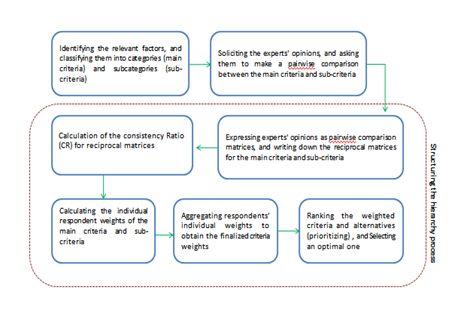
1- The author conducted a comprehensive literature review to identify the factors and sub-factors relevant to the restaurant location selection. Furthermore, research on the restaurant industry and the types of restaurants in the world and Jordan (fast-food, casual-dining, fine-dining (upscale)) were conducted.
2- The author developed the AHP model which consists of the following hierarchy: a goal that has to be achieved (Selection of the optimal location for casual-dining restaurant) and the seven criteria on which the evaluation was conducted (location, area's future, physical characteristics, visibility, traffic patterns and accessibility, competition, and costs). Each main criterion contains several sub-criteria that focus on a specific aspect of the problem, and finally, the candidate locations alternatives that are considered in the comparison. Figure 2 presents the four-level hierarchical structure and shows seven criteria, twenty-five sub-criteria, and three alternatives that should be subjected to pairwise comparison. As mentioned above, the criteria and sub-criteria were selected based on a comprehensive review of the literature on the use of the AHP methodology in decision-making, with a particular focus on facility locations (Gazi, Mondal, et al., 2023; Sipahi and Timor, 2005; Tzeng, Teng, et al., 2002).

3-The author formulated the pairwise comparison matrices for the main criteria, sub-criteria, and alternative
4- The author solicited experts' opinions. A questionnaire 61 questions (21 questions for main criteria and 40 questions for sub-criteria) was prepared to determine the priority weight of every criterion, sub-criteria, and alternative in the problem of location selection. A total of twelve experts were interviewed and their judgments were recorded. The experts interviewed were as follows: an academic (urban planning specialist), two researchers, and seven owners and managers of restaurants in the city of Irbid. To make a comparison between criteria and alternatives, each question in the questionnaire was designed based on a quantitative scale. Figure 3 shows for example the pairwise comparison question, with two out of 21 required to compare the seven main criteria that were selected. If an expert checks one of the boxes on the left, it means that they prefer the factor on the left side of the question and that this factor is more important from their point of view (e.g. "location") over the factor on the right (e.g. "physical characteristics"). Whereas if an expert checks a box on the right, this means that factor (e.g. "physical properties") is preferred over the one on the left (e.g. "location"). This comparison must also be applied to sub-criteria that belong to each main criterion. Figure 4 shows for example the last three questions of the questionnaire on pairwise comparison of three sub-criteria, " investment cost", " taxes " and " labor costs ", all of which belong to the "costs" main criterion. As for the weights in the pairwise comparisons of the alternatives, they show how well each alternative meets the main and sub-criteria, for the experts (the author choose three locations in three different neighborhoods of Irbid city).
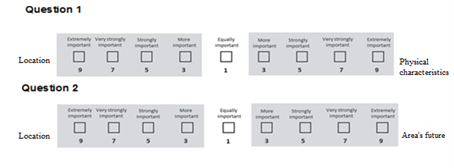

5- The author checked the consistency ratio (CR). CR value was calculated to determine the consistency of the experts' judgments. Sometimes, the expert's opinion may result in contradictions that may affect the accuracy of the judgment. Therefore, the randomness in the judgment may be assessed by calculating the consistency ratio using Equation (1). If CR is smaller than 0.10, the degree of consistency is satisfactory while the expert has to revise his judgments if the CR is more than 10%. (Shyam Prasad and Kousalya, 2017).
Equation (1): CR= CI/RI (1)
Where CI is the consistency index and RI is the random index which expresses the expected value of the CI corresponding to the order of matrices. In this study, out of ten questionnaires, the author found that one of them had consistency ratios greater than 10%. Therefore, it was not taken into account in the pairwise comparison and the model was applied based on the opinions of nine experts.
6- The author synthesized all experts' judgments by aggregating the weights using AHP to determine the priorities and to select the location of a restaurant among alternative locations.
A pairwise comparison of criteria and sub-criteria was conducted using the AHP model to achieve the goal of selecting the optimal location for a casual-dining restaurant. The author's first step for the AHP analysis was to assess the consistency of the judgments; this was done by checking the consistency of the pairwise comparison matrices for the criteria, sub-criteria, and alternatives, and found that they were all less than 10%. After ensuring the consistency of the matrix, the author calculated the relative weights of both the main criteria and sub-criteria. Figure 5. shows the results of the pairwise comparison of the main criteria. The costs criterion has the highest weight of 0.429 (42.9%), which means that it is the most important factor in selecting the optimal location for a casual-dining restaurant. The location criterion ranked in second with a weight of 0.209 (20.9%), traffic patterns and accessibility ranked in third with a weight of 0.132 (13.2%), and physical characteristics ranked in fourth with a weight of 0.096 (9.6%) while the competition, area’s future, and visibility criteria have the lowest weights of 0.052 (5.2%), 0.046 (4.6%), and 0.036 (3.6%) respectively. This result indicates that when selecting the optimal location for a casual dining restaurant, the costs criterion should have the highest priority.

According to experts, the two most important location sub-criteria include proximity to shopping centers (weight of 0.336) and proximity to cultural-sports-recreational areas (weight of 0.254). For the physical characteristics sub-criteria, the highest rank was assigned to the parking facilities (weight of 0.403) followed by the building's condition (with a weight of 0.310). In the case of sub-criteria for the area's future, the highest priority was the development of nearby areas (with 0.346), followed by area development plans (with 0.334). For sub-criteria of the traffic patterns and accessibility, vehicle traffic has the largest weight of 0.561, followed by pedestrian traffic with 0.265. With respect to the visibility criterion, the highest rank was assigned to the sub-criterion of unobstructed view (weight of 0.552) followed by the sub-criterion of visibility of signs (with a weight of 0.448). The two costs sub-criteria that obtained the most important were the investment cost (with 0.683) and the taxes (with 0.160). Finally, with respect to the competition criterion, the power of competitors' sub-criterion has the highest weight of 0.434, followed by distance to the competitors with 0.299. Figure 6. shows the results of the pairwise comparison of the sub-criteria criteria.
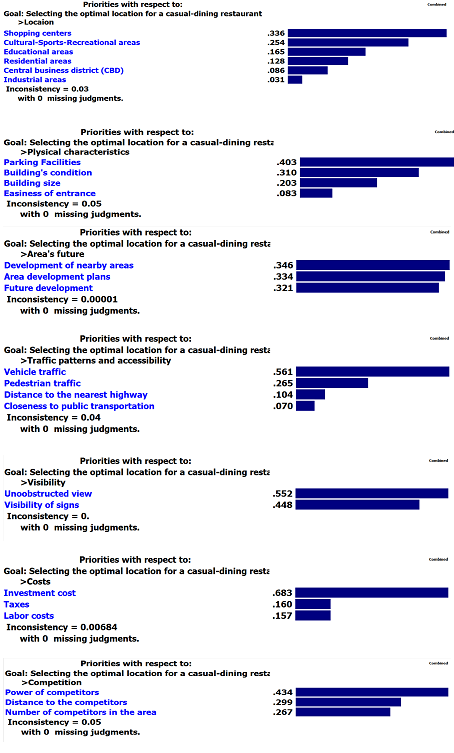
The results obtained for the prioritization of main criteria and sub-criteria can be compared with different researches in location selection problem, whether with regard to restaurants, or any other facilities or amenities:
With regard to the main criteria, the results obtained are in line with the work done in Sipahi and Timor (2005), where seven of the main criteria established in their study were used - costs, location, visibility, traffic patterns, competition, area's future, and physical characteristics - for fast food restaurant site selection. As in this study, the highest percentage was assigned to the costs criteria with a 0.2329, followed by location criteria with a 0.1747. However, there are differences regarding the other priorities obtained: visibility criteria (0.1721), traffic patterns criteria (0.1232), competition criteria (0.1087), area's future criteria (0.0994), and physical characteristics criteria (0.0890).
Wibisono and Marella (2020) used three physical features sub-criteria for selection of café location. As in this study, the physical features sub-criterion with greater relevance was the store size with a weight of 0.243. Second was the parking area with a weight of 0.088, followed by the visibility with a weight of 0.669. Similarly, in the case of competition sub-criteria, the highest priority was in the same direction as in the current study, which was obtained by the competitors' strength (0.875).
On the other hand, in Ağaç and Şimşir (2022), three cost sub-criteria were used in his research work for selecting the optimal location for a pandemic hospital. Similar to this work, the first place of local relevance was for the investment cost with a weight of 0.640. In the study carried out by Akalin, Turhan, et al. (2013) for the selection of retail store location, three competition sub-criteria were used, which obtained local weights of relevance different from the results obtained in this work. The greatest rank was for the competitors' store numbers, followed by the spatial proximity to competitors, and closeness to culture, amusement and relaxation centers.
Priorities for AlternativesAs mentioned previously (the fourth point of the study steps), after determining the aggregated weights of the main and sub-criteria, the author chose three locations in three different neighborhoods of Irbid city and applied AHP to find the score of each alternative. Score received by each location is also shown in Figure 7. Based on the AHP analysis and the sensitivity of the results, it is clear that location 1 is the most preferable alternative in terms of the seven criteria.

The results of the locations pairwise comparison under the sub-criteria show that location 1 has the highest weight of 58.7% under the areas future criterion followed by the location 2 alternative with 30.6%, and location 3 which ranked as the least preferred options with weights 10.7% as shown in Figure 8. Under the costs, competition, location, and physical characteristics sub-criteria, the same ranking of locations alternatives was obtained as under the area's future sub-criteria (see Figure 8, 9, 10, and 11). Considering visibility criterion, location 1 alternative was also ranked in the first position. However, under this criterion, location 2 ranked third, while location 3 was in the second position as shown in Figure 12. Under the traffic patterns sub-criteria, location 2 alternative was ranked in first position. However, under this criterion location 1 ranked third, while location 3 was in the first position as shown in Figure 13.
Prioritizing the location 1 alternative to be the most preferable can be explained by the fact that it is one of the new attractive neighborhoods in the city, which is witnessing a development in infrastructure and facilities. In fact, this neighborhood which is affiliated Nozha district is considered the latest extension of urban growth in the southeast of the city of Irbid (Alwedyan, 2023). Since this stage of growth and the transformation of the pattern of use in this district from agricultural use (Jawarneh, 2021) to commercial use, the number of occupational licenses has increased for all establishments located within its borders, which are issued by Greater Irbid Municipality (GIM) (Alwedyan, 2023).


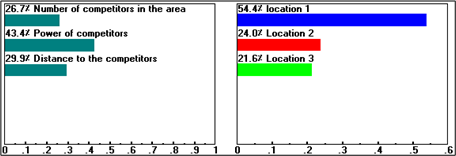
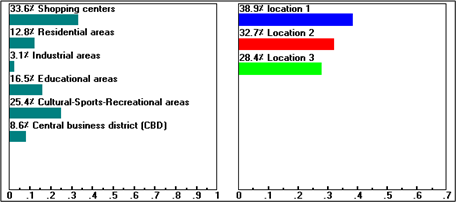
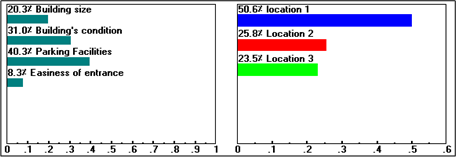
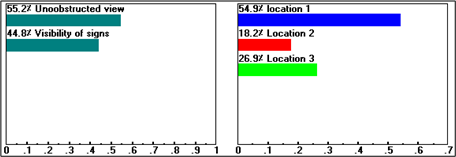

It is possible for the selection process to be affected by changes in the relative weights of the consideration criteria. As such, the author investigated the sensitivity of the decision to changes in priorities. Using Expert Choice, dynamic sensitivity graphs were developed by randomly changing the priorities given to the all selection criteria and monitoring the changes that appear in the total weights of the various location alternatives. Then, a performance sensitivity analysis was performed for the priorities given to the all selection criteria.
As presented in Figure 15, first alternative location 1 is only affected by traffic patterns criterion, while it is not vulnerable to changes in physical characteristics, location, area's future, visibility, costs or, competition criteria. Almost similarly, the second alternative location 2 is sensitive to the visibility, and traffic patterns criteria, and is not vulnerable to changes in physical characteristics, location, area's future, cost or, competition criteria. While location 3 is slightly sensitive only to the visibility criterion.
It appears that adjusting the weight of the physical characteristics, location, area's future, costs or competition criteria from their initial weight to the maximum will affect on the ranking of the alternatives. In other words, the change in rankings and weights starts to occur only after increasing the weight of the visibility and traffic patterns criteria. By increasing the weight of the traffic patterns criterion to 82.0%, location 1 ranked second, while location 2 moved to the first rank with an increase of its weight from 29.0% to 35.0%. Decreasing the weight of the criteria has no effect on the rank of any alternative. By contrast, increasing the weight of the visibility criterion from 5% to 30% moves location 3 to second place and location 2 to third place, while the rank of location 1 remains the same.

The casual-dining restaurant plays a crucial role in shaping the urban landscape, contributing not only to the vibrancy of local communities but also to broader economic and social dynamics. Casual dining restaurants serve as focal points for social interaction and cultural exchange, fostering a sense of community and connectivity. Their strategic placement within urban areas can influence the flow of foot traffic, attracting residents and visitors alike. Moreover, these establishments often act as catalysts for neighborhood development, driving demand for complementary services and contributing to the overall economic health of the area. In the realm of spatial planning, the careful consideration of casual dining locations can optimize land use, enhance urban aesthetics, and promote sustainable growth.
The restaurant industry in Jordan has experienced significant growth and development over the years. The dining scene in Jordan offers a diverse range of options, including traditional Jordanian cuisine, Middle Eastern specialties, international flavors, and fusion concepts, which have contributed to the popularity of restaurants in the country, especially casual-dining restaurants. In the restaurant industry, like any industry, the selection of the location for a restaurant is a critical decision that can significantly impact its success or failure. The problem of selecting the right location stems from various factors that must be carefully considered. The authorities in Jordan show good interest in choosing the locations of restaurants in order to ensure the well-being and sustainability of the industry, where the government recognizes the importance of a vibrant and diverse restaurant scene in promoting tourism, boosting the economy, and providing employment opportunities. Indeed, one way the authorities demonstrate their interest is through zoning regulations and urban planning, where they establish guidelines and regulations that govern the location of restaurants, ensuring that they are appropriately distributed in different neighborhoods and regions within the country. Such interest reflects the critical importance of optimal location selection in this industry.
The main objective of this study was to selection the optimal location for a casual-dining restaurant in Irbid City, Jordan. Because of the many decision-making criteria and other factors that govern the selection of the optimal location for a casual-dining restaurant, the selection is not a straightforward process. It rather entails a multi-criteria decision-making process. Therefore, AHP was accepted to identify the criteria and alternatives based on soliciting experts' opinions.
The findings indicate that experts' preference for the location criterion of a casual-dining restaurant is proximity to shopping centers, as well as cultural-sports-recreational areas and educational areas. Obviously, this preference will create high costs. According to the experts' judgments, it is found that casual-dining restaurants require dense traffic, mostly vehicles. Depending upon the fact that some customers will arrive by car, parking facilities were identified as one of the most important sub-criteria for traffic patterns. However, a good location and dense traffic are not enough. The competition, area's future, and visibility are also other important factors for location selection decision.
The pairwise comparisons results revealed that the location 1 is the most preferable alternative among the three locations considered in the study. Prioritizing the location 1alternative to be the most preferable can be explained by the fact that it is one of the new attractive neighborhoods in the city, which is witnessing a development in infrastructure and facilities. Dynamic sensitivity analysis revealed that rankings of the locations alternatives start to change only after increasing the weight of the visibility and traffic patterns criteria.
It appears from the results of the study that that AHP is a useful tool that enables decision-making regarding to identifying casual-dining restaurant location selection factors and identifying location alternatives. It is recommended that future research focus on finding suitable locations to locate facilities and other amenities in all cities of the country.
While the study provides valuable insights into the optimal location selection for a casual-dining restaurant in Irbid City, Jordan, some limitations should be acknowledged. First of all, the study focuses specifically on Irbid City, which may not be representative of the entire country. Different cities or regions within Jordan may have unique factors influencing optimal restaurant locations that were not considered in this study. Secondly, the study may be subject to temporal constraints, as the dynamics of urban development, infrastructure, and economic conditions can change over time. The findings may not account for future changes in the city's landscape or economic environment. Finally, the study relies on expert opinions to identify criteria and alternatives. While expert opinions are valuable, they are subjective and may vary among different professionals. Additionally, the selection of experts could introduce bias, and different experts might prioritize criteria differently. Addressing these limitations in future research could contribute to a more comprehensive understanding of the factors influencing restaurant location selection in Jordan or similar contexts.
Conceptualization, A. S.; methodology, A. S.; software, A. S.; investigation, A. S.; resources, A. S.; data curation, A. S.; writing—original draft preparation, A.S.; writing—review and editing, A.S.
The author declares that they have no conflicts of interest regarding the publication of the paper.
The author would like to thank all participants for their valuable contributions.
This research did not receive any specific grant from funding agencies in the public, commercial, or not-for-profit sectors.